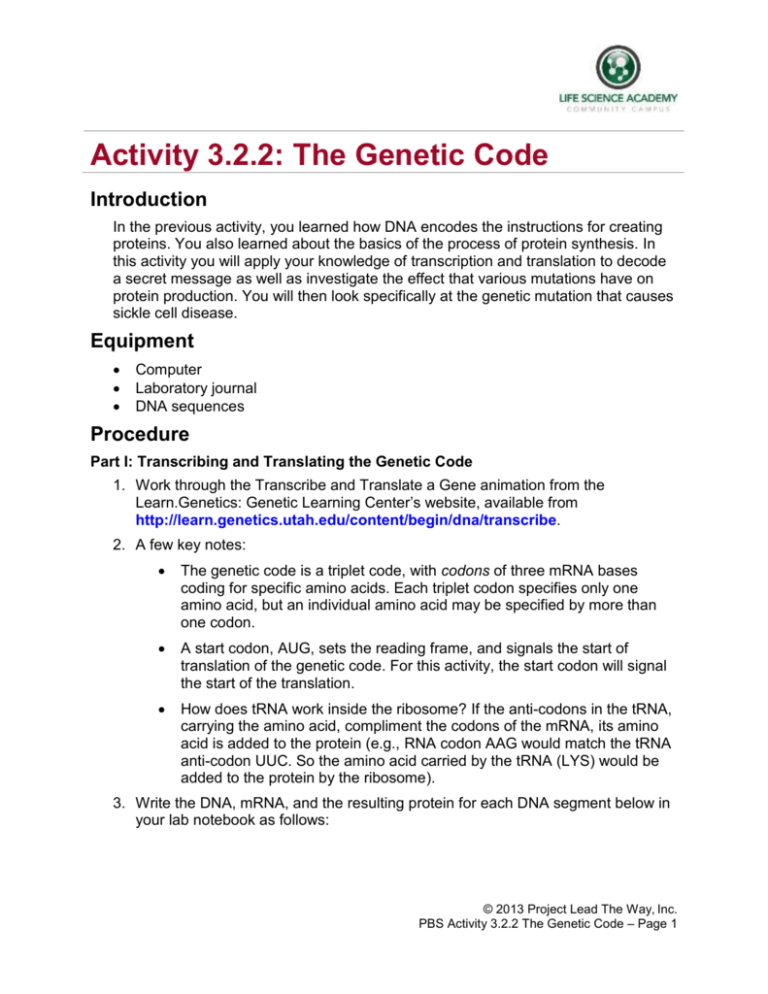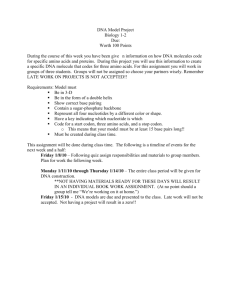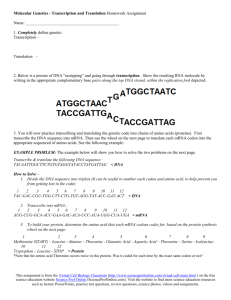Activity 3.2.2: The Genetic Code Introduction
advertisement

Activity 3.2.2: The Genetic Code Introduction In the previous activity, you learned how DNA encodes the instructions for creating proteins. You also learned about the basics of the process of protein synthesis. In this activity you will apply your knowledge of transcription and translation to decode a secret message as well as investigate the effect that various mutations have on protein production. You will then look specifically at the genetic mutation that causes sickle cell disease. Equipment Computer Laboratory journal DNA sequences Procedure Part I: Transcribing and Translating the Genetic Code 1. Work through the Transcribe and Translate a Gene animation from the Learn.Genetics: Genetic Learning Center’s website, available from http://learn.genetics.utah.edu/content/begin/dna/transcribe. 2. A few key notes: The genetic code is a triplet code, with codons of three mRNA bases coding for specific amino acids. Each triplet codon specifies only one amino acid, but an individual amino acid may be specified by more than one codon. A start codon, AUG, sets the reading frame, and signals the start of translation of the genetic code. For this activity, the start codon will signal the start of the translation. How does tRNA work inside the ribosome? If the anti-codons in the tRNA, carrying the amino acid, compliment the codons of the mRNA, its amino acid is added to the protein (e.g., RNA codon AAG would match the tRNA anti-codon UUC. So the amino acid carried by the tRNA (LYS) would be added to the protein by the ribosome). 3. Write the DNA, mRNA, and the resulting protein for each DNA segment below in your lab notebook as follows: © 2013 Project Lead The Way, Inc. PBS Activity 3.2.2 The Genetic Code – Page 1 DNA Fragment #: _____ DNA: mRNA (codons): Protein (amino acid sequence): DNA Segments: #1TACCATTGAAAGCATATCGAATGATGGAATTAAGTGGGCAACAGC #2TACGGCGAATAGAAACATATAGAATATTGATGGAATTAGGTCAAAGAGGAAAGT #3 TACTGGGGGCATGTTTGATGCAAGGCTGTTGTGTGACATGTATAATGTAATAACAAA #4TACCATTGAAAGCACATCGAATGATGGGGCCATGTATAATGCAAGGCCGTCGTG #5 TACTGGGGCGAGTAGTGGACAGCGCATATGTAGCATGTTACTAAAGCGTGGGAA #6 TACGCACTCTACTAATGGAATAACACTTGAGCCTAAAGTAAGGCTATGGAG #7 TACTGCAACCTTGAATGATGGAATTAGGTTTGTGGCAATAACATC #8 TACTGTGCGAAGAAATGATTAGAATAGAAGGCCTGGATTACA #9 TACTGGAACGACGCTATCTAGCATGTGTAATTCAATAATGAC 4. Choose one DNA segment and illustrate both transcription and translation using materials provided by your teacher. You will present your “explanation” to the class. Summarize your plan below and have it checked by your teacher. © 2013 Project Lead The Way, Inc. PBS Activity 3.2.2 The Genetic Code – Page 2 II: Mistakes Happen Part The sequence of nucleotides in a DNA molecule determines the sequence of amino acids in a protein. If the nucleotide sequence is changed, then the amino acid sequence may also change. Any change in DNA is called a mutation. You will now investigate the effect of base pair mutations on your finished protein. 5. Make a mutation to one of your DNA codes. Choose any base in your DNA sequence (with the exception of the first three bases, as these bases code for the start codon) and randomly change it to another base. For example, choose a C and make it a G. 6. Transcribe and translate the mutated DNA (as you did in Part I) below. NOTE: You will perform this part of the activity with pen and paper and do not need to cut out the associated pieces. DNA: mRNA (codons): Protein (amino acid sequence): 7. Answer Conclusion question 1. 8. Make a different mutation to your DNA code. Randomly delete one of the bases in your original DNA strand. NOTE: Do not delete one of the first three bases. Remember that DNA will be read in groups of three. If a deletion occurs, all shifts over and the ribosome simply reads the next group of three in the chain. 9. Transcribe and translate the mutated DNA below. DNA: mRNA (codons): Protein (amino acid sequence): 10. Answer Conclusion questions 2 - 5. © 2013 Project Lead The Way, Inc. PBS Activity 3.2.2 The Genetic Code – Page 3 Part III: Sickle Cell Disease A single genetic mutation in the hemoglobin gene can cause sickle cell anemia. You will analyze the first seven amino acids for normal versus sickle cell hemoglobin gene in order to determine what type of mutation is responsible for causing sickle cell disease. (Note that the gene coding for hemoglobin is 146 amino acids. In this activity you will only work with a small portion of this gene.) 11. Transcribe and translate the DNA sequence of bases for the first 7 amino acids in Normal hemoglobin below. Use the codon chart as your guide. DNA: C A C G T G G A C T G A G G A C T C C T C mRNA: Protein (amino acid sequence): 12. Transcribe and translate the DNA sequence of bases for the first 7 amino acids in Sickle hemoglobin below. Use the codon chart as your guide. DNA: C A C G T G G A C T G A G G A C A C C T C mRNA: Protein (amino acid sequence): © 2013 Project Lead The Way, Inc. PBS Activity 3.2.2 The Genetic Code – Page 4 Conclusion 1. Describe (in words) the effect of the mutation. 2. Was the mutational effect greater in a substitution or a deletion? Explain your answer clearly. 3. Why do you think scientists call a substitution a “point mutation”? Why do you think scientists call a deletion (or an insertion) a “frameshift mutation”? 4. Note the two transcribed and translated DNA strips below. The two strips are identical except for a point mutation, where the 15th base was changed from a G to a T. Fill in the corresponding mRNA, tRNA, and letter in the blanks below for the mutated DNA strip. In the space below, explain how this point mutation changes the protein. Normal DNA: GTTGGCGAATGAACGGAGGCTGACGTCTAAGCCTAGAAAAATTGG mRNA: CAACCGCUUACUUGCCUCCGACUGCAGATTCGGAUCUUU UUAACC tRNA: GUUGGCGAAUGAACGGAGGCUGACGUCUAAGCCUAGAAAAAUUGG Mutated DNA: GTTGGCGAATGAAC___GAGGCTGACGTCTAAGCCTAGAAAAATTGG mRNA: CAACCGCUUACUU___CUCCGACUGCAGATTCGGAUCUUU UUAACC tRNA: GUUGGCGAAUGAA___GAGGCUGACGUCUAAGCCUAGAAAAAUUGG © 2013 Project Lead The Way, Inc. PBS Activity 3.2.2 The Genetic Code – Page 5 5. What is the difference between normal and sickle hemoglobin at the DNA, RNA, and protein (amino acid) level? 6. What type of mutation is the sickle hemoglobin mutation? Explain. 7. Glutamic acid (Glu) and valine (Val) are two amino acids with different molecular structures. (Glutamic acid is a strongly hydrophilic molecule, and valine is a strongly hydrophobic molecule. This is something you will learn more about in the next activity). Why do you think switching the hemoglobin gene’s sixth amino acid from glutamic acid to valine would affect the hemoglobin protein? © 2013 Project Lead The Way, Inc. PBS Activity 3.2.2 The Genetic Code – Page 6







